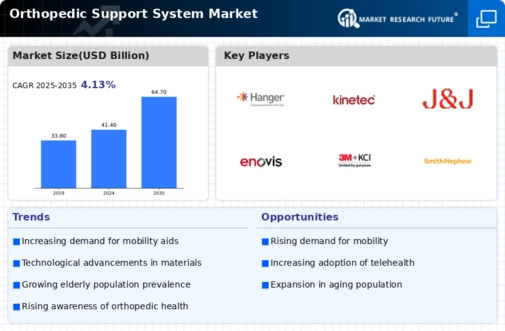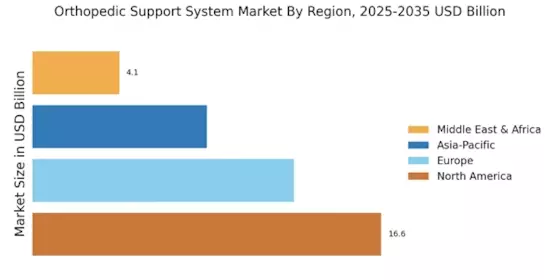The Orthopedic Support System Market is characterized by a dynamic competitive landscape, driven by technological advancements, an aging population, and increasing incidences of musculoskeletal disorders. Major players such as DePuy Synthes (US), Stryker (US), and Zimmer Biomet (US) are at the forefront, each adopting distinct strategies to enhance their market positioning. DePuy Synthes (US) focuses on innovation through the development of advanced orthopedic implants and surgical instruments, while Stryker (US) emphasizes digital transformation, integrating smart technologies into their product offerings. Zimmer Biomet (US) is actively pursuing mergers and acquisitions to expand its portfolio and market reach, thereby intensifying competition within the sector.
The business tactics employed by these companies include localizing manufacturing to reduce costs and optimize supply chains, which is particularly crucial in a moderately fragmented market. This competitive structure allows for a diverse range of products and services, with key players exerting considerable influence over market trends and consumer preferences. The collective strategies of these companies not only enhance their operational efficiencies but also contribute to a more resilient market framework.
In August 2025, Stryker (US) announced the launch of its new robotic-assisted surgical system, which is designed to improve precision in orthopedic surgeries. This strategic move is significant as it positions Stryker as a leader in the integration of robotics within orthopedic procedures, potentially enhancing patient outcomes and operational efficiencies for healthcare providers. The introduction of such innovative technologies is likely to reshape surgical practices and set new standards in the industry.
In September 2025, Zimmer Biomet (US) completed the acquisition of a leading digital health company, which aims to enhance its capabilities in remote patient monitoring and data analytics. This acquisition is pivotal as it aligns with the growing trend towards personalized medicine and telehealth solutions, allowing Zimmer Biomet to offer more comprehensive care solutions. By integrating digital health technologies, the company is poised to improve patient engagement and streamline post-operative care, thereby reinforcing its competitive edge.
In July 2025, DePuy Synthes (US) launched a new line of biodegradable orthopedic implants, reflecting a commitment to sustainability and environmental responsibility. This initiative is particularly relevant in the current market context, where there is an increasing demand for eco-friendly medical solutions. By prioritizing sustainability, DePuy Synthes not only addresses regulatory pressures but also appeals to a growing segment of environmentally conscious consumers, potentially enhancing its brand reputation and market share.
As of October 2025, the Orthopedic Support System Market is witnessing trends such as digitalization, sustainability, and the integration of artificial intelligence in product development. Strategic alliances among key players are increasingly shaping the competitive landscape, fostering innovation and collaboration. Looking ahead, it appears that competitive differentiation will evolve from traditional price-based strategies to a focus on innovation, technological advancements, and supply chain reliability, thereby redefining the parameters of success in this sector.


















Leave a Comment